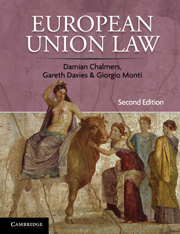Book contents
- Frontmatter
- Contents
- Map
- Preface
- Abbreviations
- Table of Cases
- Table of Treaties, Instruments and Legislation
- Table of Equivalents
- Electronic Working Paper Series
- 1 European Integration and the Treaty on European Union
- 2 The EU Institutions
- 3 Union Law-making
- 4 The EU Judicial Order
- 5 The Authority of EU Law
- 6 Fundamental Rights
- 7 Rights and Remedies in National Courts
- 8 Infringement Proceedings
- 9 Governance
- 10 Judicial Review
- 11 EU citizenship
- 12 EU Law and Non-EU Nationals
- 13 Equal Opportunities Law and Policy
- 14 EU Criminal Law
- 15 External Relations
- 16 The Internal Market
- 17 Economic and Monetary Union
- 18 The Free Movement of Goods
- 19 The Free Movement of Services
- 20 The Pursuit of an Occupation in Another Member State
- 21 Trade Restrictions and Public Goods
- 22 EU Competition Law: Function and Enforcement
- 23 Antitrust and Monopolies
- 24 State Regulation and EU Competition Law
- Index
19 - The Free Movement of Services
- Frontmatter
- Contents
- Map
- Preface
- Abbreviations
- Table of Cases
- Table of Treaties, Instruments and Legislation
- Table of Equivalents
- Electronic Working Paper Series
- 1 European Integration and the Treaty on European Union
- 2 The EU Institutions
- 3 Union Law-making
- 4 The EU Judicial Order
- 5 The Authority of EU Law
- 6 Fundamental Rights
- 7 Rights and Remedies in National Courts
- 8 Infringement Proceedings
- 9 Governance
- 10 Judicial Review
- 11 EU citizenship
- 12 EU Law and Non-EU Nationals
- 13 Equal Opportunities Law and Policy
- 14 EU Criminal Law
- 15 External Relations
- 16 The Internal Market
- 17 Economic and Monetary Union
- 18 The Free Movement of Goods
- 19 The Free Movement of Services
- 20 The Pursuit of an Occupation in Another Member State
- 21 Trade Restrictions and Public Goods
- 22 EU Competition Law: Function and Enforcement
- 23 Antitrust and Monopolies
- 24 State Regulation and EU Competition Law
- Index
Summary
INTRODUCTION
Article 56 TFEU prohibits restrictions on the provision of services between Member States. Trade in services comprises the largest part of a modern economy, yet interstate trade is hindered by the high level of regulation applying to many service activities. EU law has taken a threefold approach to breaking down these barriers: the direct application of Article 56 by courts is now complemented by Directive 2006/123/EC on services in the internal market (‘Services Directive’), and by sector specific regulation for many complex services of particular social or economic importance. This chapter addresses Article 56 and the Services Directive. It is organised as follows.
Section 2 provides an overview of why services markets are hard to integrate. Because services involve people interacting, they raise issues of power and knowledge inequalities, requiring protective legislation. Also, services are often of great social importance and some services arouse strong moral feelings.
Section 3 is concerned with defining the services to which Article 56 applies. A core aspect is that the services must be provided for remuneration. Genuinely non-economic services, such as free public education, are excluded. Yet, where the service consumer, or an insurer acting on her behalf, does pay for services, Article 56 applies, however socially sensitive the services may be. Health care has been subjected to Article 56 on this basis.
- Type
- Chapter
- Information
- European Union LawCases and Materials, pp. 783 - 828Publisher: Cambridge University PressPrint publication year: 2010

